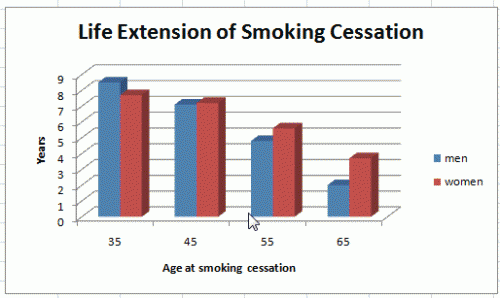I am going to do some follow up posts on the discussion last week of how to use smoking cessation research to answer practical questions about how much longer a person would live if they stopped smoking. The point of the paper on which the post was based was to denominate the benefits of smoking cessation in a format that was readily understandable with a goal of providing information that could help spur smokers to attempt cessation. We felt that life years gained from cessation was about as clear as it could get.
The first question that needs to be answered when seeking to quantify the benefits of smoking cessation is “as compared to what?” The counterfactual is the conceptual key to estimating and communicating the magnitude of any cessation benefits. To provide a quantitative estimate, we needed several things:
- Long term follow up of a population at risk of smoking. We used the American Cancer Society’s (ACS) Cancer Prevention Study II (CPS-II), a prospective cohort study begun in 1982 that included 1.2 Million persons as of December 31, 1996. There are selection effects introduced by the use of this survey that will be discussed in later posts (more educated, more white, than U.S. population).
- Data on smoking, collected via self report in the CPS-II.
- Data on mortality for CPS-II participants, collected via ACS inquiries in 1984, 1986, 1988 and through checks against the National Death Index in December of 1989, 1991, 1994 and 1996 (Dec. 31, 1996 is censor date). Death certificates with multiple causes were collected for 98.6% of deaths.
There are several other key aspects of the study methodology:
- We excluded CPS-II participants with incomplete data on smoking and/or history of pipe or cigar smoking (excl. 138,669 men; 72,459 women) and persons reporting being sick at study entry because they may have changed smoking status due to illness (34,824 men, 61,522 women).
- After exclusions, the analysis sample included observations from date of study entry until December 31, 1996 resulting in 7.2 Million person years of female follow up and 4.3 million male person years.
- We used all cause mortality and not simply death from smoking related diseases.
- A sub-study conducted in 1992 assessed smoking status changes for a subset of the CPS-II cohort, allowing us to adjust for smoking status changes over time that would otherwise have to be assumed to be constant based on initial assessment when a subject entered the CPS-II cohort.
- We identified the relative risk of death by age, race and smoking status from CPS-II and applied these to the 1990 Census population to estimate age, sex, race and smoking specific mortality rates. (**more detail below the figure)
- Finally, we constructed a model that allowed us to simulate how cessation at particular ages would alter mortality and quantify the life extension of smoking cessation as compared to different counterfactuals.
The estimated benefits of smoking cessation for longevity are summarized in the figure; over 8 years for males stopping at age 35 as compared to a 35 year old smoker male who smoked until their death. For females, cessation at age 35 increased expected lifespan by nearly 8 years. Even cessation at age 65 resulted in meaningful life extensions, again as compared to a 65 year old smoker who continued until death. In future posts, I will talk about the selection biases introduced by using CPS-II to obtain the relative risk of death due to smoking, the model simulations used to quantify longevity extensions due to cessation, what all this means for interpreting/using our results and whether there are opportunities and a need to update this research.
**More detail on RR estimation. We estimated the relative risk of death by smoking status using the CPS-II data using Cox proportional hazards model controlling for age (in 1 year increments) and sex. Final models were estimated separately for men and women, and for those older and younger than age 70, controlling for age in 1 year increments within those groupings. Initially, smoking was assumed to remain constant during the follow up period (1982-1996, or death) as measured by the self report in CPS-II.
Assuming static smoking status could result in two types of bias: persons classified as current smokers at baseline who later quit, and former smokers at baseline who relapsed. Both sources of bias would serve to underestimate the positive impacts of smoking cessation on longevity. If current smokers at baseline quit, then the negative impact of smoking would be underestimated. If former smokers relapsed, the the benefits of cessation would be underestimated; both errors bias towards no difference in life span by smoking status. The 1992 follow up study for a subset of CPS-II showed that cessation was far more common (56.8% of male current smokers in 1982 did not smoke in 1992; 52.7% for females). Relapse rates were much lower, on the order of 3%, and never smokers initiating in middle-to-late age were miniscule.
Relative risk of mortality rates obtained from the CPS-II stratified by age, race, sex and smoking status were applied to the 1990 Census population, stratified by age, race and sex. We then divided by a factor representing the weighted average of the category-specific relative risks to obtain estimated mortality rates for each age, race sex and smoking status group. Life extensions were shown with and without an adjustment for smoking cessation (those in graph above are with this adjustment) but no adjustment was made for relapse. Again, this biases findings toward no effect of cessation.
Donald H. Taylor, Jr, Vic Hasselblad, Jane Henley, Michael J. Thun, Frank A. Sloan. Benefits of Smoking Cessation for Longevity. American Journal of Public Health 2002;92(6):990-996.


